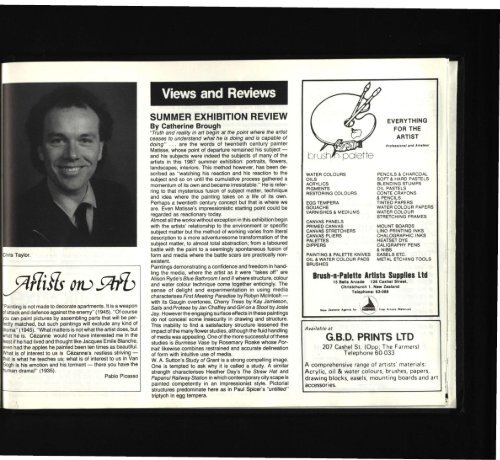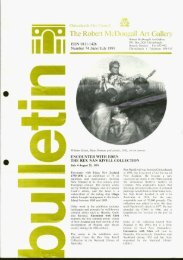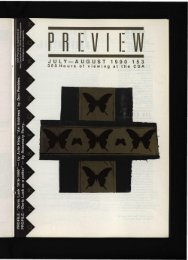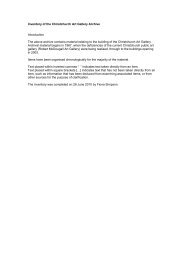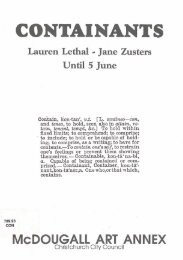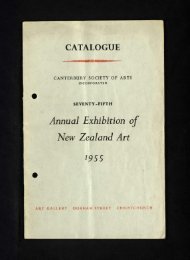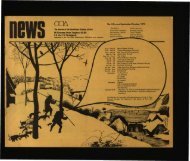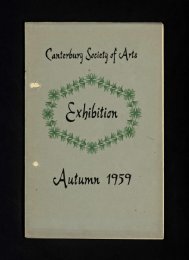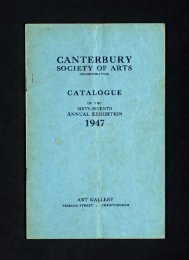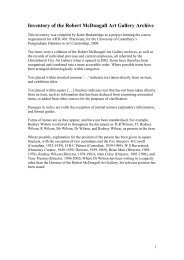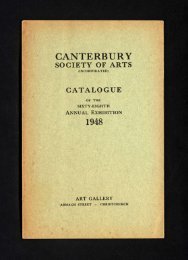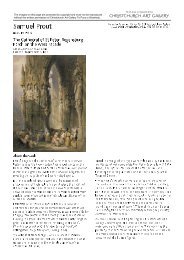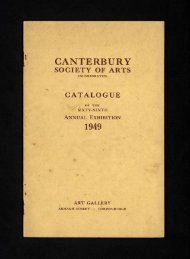Download (4.1 MB) - Christchurch Art Gallery Te Puna O Waiwhetu
Download (4.1 MB) - Christchurch Art Gallery Te Puna O Waiwhetu
Download (4.1 MB) - Christchurch Art Gallery Te Puna O Waiwhetu
- No tags were found...
You also want an ePaper? Increase the reach of your titles
YUMPU automatically turns print PDFs into web optimized ePapers that Google loves.
Views and Reviews<br />
Chris Taylor.<br />
JZflitfs<br />
otv Stfb<br />
Painting is not made to decorate apartments. It is a weapon<br />
Df attack and defence against the enemy" (1945). "Of course<br />
you can paint pictures by assembling parts that will be perectly<br />
matched, but such paintings will exclude any kind of<br />
drama" (1945). "What matters is not what the artist does, but<br />
what he is. Cezanne would not have interested me in the<br />
east if he had lived and thought like Jacques Emile Blanche,<br />
even had the apples he painted been ten times as beautiful.<br />
What is of interest to us is Cezanne's restless striving —<br />
that is what he teaches us; what is of interest to us in Van<br />
Gogh is his emotion and his torment — there you have the<br />
human drama!" (1935).<br />
Pablo Picasso<br />
SUMMER EXHIBITION REVIEW<br />
By Catherine<br />
Brough<br />
"Truth and reality in art begin at the point where the artist<br />
ceases to understand what he is doing and is capable of<br />
doing" ... are the words of twentieth century painter<br />
Matisse, whose point of departure remained his subject —<br />
and his subjects were indeed the subjects of many of the<br />
artists in this 1987 summer exhibition: portraits, flowers,<br />
landscapes, interiors. This method however, has been described<br />
as "watching his reaction and his reaction to the<br />
subject and so on until the cumulative process gathered a<br />
momentum of its own and became irresistable." He is referring<br />
to that mysterious fusion of subject matter, technique<br />
and idea where the painting takes on a life of its own.<br />
Perhaps a twentieth century concept but that is where we<br />
are. Even Matisse's impressionistic starting point could be<br />
regarded as reactionary today.<br />
Almost all the works without exception in this exhibition begin<br />
with the artists' relationship to the environment or specific<br />
subject matter but the method of working varies from literal<br />
description to a more adventuresome transformation of the<br />
subject matter, to almost total abstraction; from a laboured<br />
battle with the paint to a seemingly spontaneous fusion of<br />
form and media where the battle scars are practically nonexistent.<br />
Paintings demonstrating a confidence and freedom in handling<br />
the media, where the artist as it were "takes off" are<br />
Alison Ryde's Blue Bathroom I and II where structure, colour<br />
and water colour technique come together enticingly. The<br />
sense of delight and experimentation in using media<br />
characterises First Meeting Paradise by Robyn Mcintosh —<br />
with its Gaugin overtones, Cherry Trees by Kay Jamieson,<br />
Sails and Proteas by Jan Chaff ey and Girl on a Stool by Josie<br />
Jay. However the engaging surface effects in these paintings<br />
do not conceal some insecurity in drawing and structure.<br />
This inability to find a satisfactory structure lessened the<br />
impact of the many flower studies, although the fluid handling<br />
of media was appealing. One of the more successful of these<br />
studies is Burmese Vase by Rosemary Roake whose Portrait<br />
likewise combines restrained and accurate delineation<br />
of form with intuitive use of media.<br />
W. A. Sutton's Study of Grant is a strong compelling image.<br />
One is tempted to ask why it is called a study. A similar<br />
strength characterises Heather Day's The Straw Hat and<br />
Papanui Railway Station in which contemporary city scape is<br />
painted competently in an impressionist style. Pictorial<br />
structures predominate here as in Paul Spicer's "untitled"<br />
triptych in egg tempera.<br />
brush^vpalete<br />
WATER COLOURS<br />
OILS<br />
ACRYLICS<br />
PIGMENTS<br />
RESTORING COLOURS<br />
EGG TEMPERA<br />
GOUACHE<br />
VARNISHES & MEDIUMS<br />
CANVAS PANELS<br />
PRIMED CANVAS<br />
CANVAS STRETCHERS<br />
CANVAS PLIERS<br />
PALETTES<br />
DIPPERS<br />
PAINTING 4 PALETTE KNIVES<br />
OIL & WATER COLOUR PADS<br />
BRUSHES<br />
EVERYTHING<br />
FOR THE<br />
ARTIST<br />
Profusion!! «nd Amjtour<br />
PENCILS & CHARCOAL<br />
SOFT & HARD PASTELS<br />
BLENDING STUMPS<br />
OIL PASTELS<br />
CONTE CRAYONS<br />
4 PENCILS<br />
TINTED PAPERS<br />
WATER COLOUR PAPERS<br />
WATER COLOUR<br />
STRETCHING FRAMES<br />
MOUNT BOARDS<br />
LINO PRINTING INKS<br />
CHALOGRAPHIC INKS<br />
HEATSET DYE<br />
CALIGRAPHY PENS<br />
& NIBS<br />
EASELS ETC.<br />
METAL ETCHING TOOLS<br />
Brush-n-Palete <strong>Art</strong>istsSuppliesLtd<br />
15 Balls Arcade 126 Cashel Street.<br />
<strong>Christchurch</strong> 1. New Zealand<br />
<strong>Te</strong>lephone: 63-088<br />
Nev. 2«al»nd Agent* for<br />
tin* <strong>Art</strong>itt* Materials<br />
Available at<br />
G.B.D. PRINTS LTD<br />
207 Cashel St. (Opp; The Farmers)<br />
<strong>Te</strong>lephone 60 033<br />
A comprehensive range of artists' materials:<br />
Acrylic, oil & water colours, brushes, papers,<br />
drawing blocks, easels, mounting boards and art<br />
accessories.


